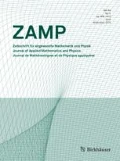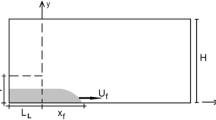Summary
This paper discusses the fundamental aspects of the hydraulic lock-exchange problem. In a first part the limit of small density ratios of the two fluids involved is discussed by considering the problem of emptying a horizontal water-filled channel by means of pressurized air.
To study the problem for arbitrary density ratios, the general case of two fluids of different densities in a closed horizontal channel that are initially separated by a vertical splitter plate is considered. At timet=0 (say) the separating plate is suddenly removed and thus initiates the lock-exchange flow. Generally, a complete lock-exchange flow involves an essentially loss-free gravity current of low-density fluid penetrating into a part of the channel that was originally filled with high-density fluid. An expansion wave that runs in the same direction follows this gravity current at a somewhat lower speed and connects it to a counter-running gravity current of high-density fluid penetrating into a part of the channel that was originally filled with low-density fluid. At density ratiosr≲0.281 this gravity current of high-density fluid exhibits a dissipative character, i.e. in a frame of reference moving with the gravity current the flow behind it is subcritical. As the density ratio exceeds the value 0.281 the gravity current may essentially become loss-free. In this case the flow behind it becomes supercritical and the loss-free gravity current is followed by an internal hydraulic jump.
Zusammenfassung
Diese Arbeit befasst sich mit den grundlegenden Aspekten der hydraulischen Ausgleichsströmungen. In einem ersten Teil wird der Grenzfall eines kleinen Dichteverhältnisses zweier Fluida anhand der Betrachtung des Entleerungsproblems eines horizontalen wassergefüllten Kanals mittels Pressluft diskutiert.
Zur Untersuchung des Problems für beliebige Dichteverhältnisse wird der allgemeine Fall zweier Fluida verschiedener Dichte in einem geschlossenen horizontalen Kanal betrachtet, die anfänglich durch eine vertikale Trennwand voneinander getrennt sind. Zu einer Zeitt=0 wird die Trennwand plötzlich entfernt, und die Ausgleichsströmung setzt ein. Im allgemeinen besteht eine vollständige Ausgleichsströmung aus einem Schwerestrom eines leichten Fluids, der in einen Kanalbereich eindringt, welcher ursprünglich mit einem schweren Fluid gefüllt war. Eine Expansionswelle, die mit etwas kleinerer Geschwindigkeit in die gleiche Richtung läuft, folgt diesem Schwerestrom and verbindet ihn mit einem in Gegenrichtung laufenden Schwerestrom hoher Dichte, der in einem Kanalbereich eindringt, welcher ursprünglich mit leichtem Fluid gefüllt war. Für Dichteverhältnisser≲0.281 weist dieser Schwerestrom einen dissipativen Charakter auf-oder anders ausgedrückt-in einem Bezugssystem, das sich mit dem Schwerestrom bewegt, ist die nachfolgende Strömung unterkritisch. Wenn das Dichteverhältnis den Wert 0.281 übersteigt, kann der Schwerestrom grundsätzlich verlustfrei sein. In diesem Fall wird die nachfolgende Strömung überkritisch und der verlustfreie Schwerestrom wird von einem inneren hydraulischen Sprung gefolgt.
Similar content being viewed by others
References
T. B. Benjamin,Gravity currents and related phenomena. J. Fluid Mech.31, 209 (1968).
J. E. Simpson,Gravity currents in the laboratory, atmosphere, and ocean. Ann. Rev. Fluid Mech.14, 213 (1982).
J. J. Keller, W. Egli and J. Exley,Force- and loss-free transitions between flow states. Z. angew. Math. Phys.36, 854 (1985).
J. J. Keller, W. Egli and R. Althaus,Vortex breakdown as a fundamental element of vortex dynamics. Z. angew. Math. Phys.39, 404 (1988).
L. Armi,The hydraulics of two flowing layers with different densities. J. Fluid Mech.163, 27 (1986).
C.-S. Yih and C. R. Guha,Hydraulic jump in a fluid system of two layers. Tellus7, 358 (1955).
I. R. Wood and J. E. Simpson,Jumps in layered miscible fluids. J. Fluid Mech.140, 329 (1984).
J. E. Simpson and R. E. Britter,The dynamics of the head of a gravity current advancing over a horizontal surface, J. Fluid Mech.94, 477 (1979).
G. Abraham and C. B. Vreugdenhil,Discontinuities in stratified flows, J. Hydraulic Research9, 293 (1971).
H. Schlichting,Boundary-Layer Theory. 6th ed. McGraw-Hill, New York 1966.
Author information
Authors and Affiliations
Rights and permissions
About this article
Cite this article
Keller, J.J., Chyou, Y.P. On the hydraulic lock-exchange problem. Z. angew. Math. Phys. 42, 874–910 (1991). https://doi.org/10.1007/BF00944569
Received:
Revised:
Issue Date:
DOI: https://doi.org/10.1007/BF00944569




